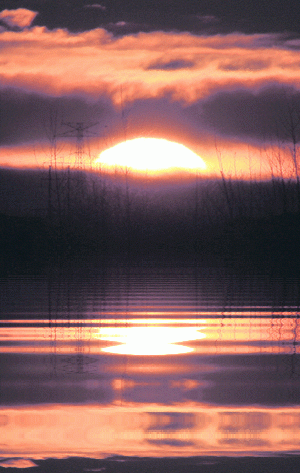
Finally, the heavens shone down upon me, we had clear skies, mind you -40c windchill, but still clear skies and was able to get some pics of the beautiful Lunar Venus conjunction last night.
I hope you all got to see it as well, Genie did and got a great pic. I decided to do something different this time, change my picture taking venue, went downtown.
It is amazing the amount of people walking, and jogging, that's right jogging around downtown at -40c with windchill. Had a lot of people stopping to see what was going on, I explained and pointed to the Moon and Venus, they all looked up and said things like I didn't know, or that is pretty, all of them thought Venus was a star, no worries, Astro Bob set them straight, gotta do my part for the International Year Of Astronomy 2009.
You'll notice I took a lot of images, hey not very often I get clear skies and an event at the same time, and with the forecast for snow and clouds this coming Monday for the Lunar Pleiades conjunction, I thought I would really go crazy with this one.
Spent nearly 4 hours imaging and traveling in the car to various places taking pics. Final stop was just outside of town where my horizon shots were taken. Got a cool cloud effect on the Moon, notice the color starting to change from white to an orange as they start to set.
Got a cool cloud effect on the Moon, notice the color starting to change from white to an orange as they start to set.
At Black hokes I always try to do something a little different every now and then, the image below certainly qualifies. All I did was download Paint.net processing software, in the program under effects there is something called "Polar Inversion" clicked on it, and it transformed one of my Lunar Venus image into something , well very different, lots of Moons, lots of Venuses and lots of trees..... good enough for mes.
Another positive, I was just reading on Universe Today, an excellent site, I highly recommend you subscribe to them, about the Obama administration going ahead with Bush's plan to put a man on the Moon by 2020. A pleasant surprise indeed, who knows they may still be in the race for the Moon.
I'll leave you with a clip I put together of 70 images, real time 10 minutes. Courtesy of Planetary Mechanics, the celestial pairing of the Moon and Venus setting in the west, a beautiful orange combo.
Saturday, February 28, 2009
The Lunar Venus Conjunction
Thursday, February 26, 2009
On Going to The Moon and Beyond
 "The Earth is just too small and fragile a basket for the Human Race to keep all it's eggs in", Robert Heinlein.
"The Earth is just too small and fragile a basket for the Human Race to keep all it's eggs in", Robert Heinlein.
Woo Hoo, stopped snowing, but along with the no snow comes the -30c weather, sucks. In between the snow and clouds I got some clear skies. I was able to get some images the other day of a pretty crescent Moon and added a cool oil painting effect.
In my observing down times I have been watching "From The Earth to The Moon" on HBO, an interesting show about our adventure to the Moon. Also been watching for the like gazillionth time "In The Shadow Of the Moon", and... and I've been reading, "The Last Man On the Moon" an excellent book about the Apollo missions from the standpoint of an actual astronaut Gene Cernan. You may have noticed an underlining theme to all the above, I love the Moon, but most importantly, the fact we made it there, hopefully to return one day.
Well maybe not so much. I've also been reading a paper that was just released out of Rice University. Rice University and NASA go back a long way. Rice University back in 1962 donated a lot of land for NASA's Manned Spacecraft center, later named the Johnson Space Center. The donation prompted Kennedy to make a famous speech from Rice Stadium where he states;
Rice University and NASA go back a long way. Rice University back in 1962 donated a lot of land for NASA's Manned Spacecraft center, later named the Johnson Space Center. The donation prompted Kennedy to make a famous speech from Rice Stadium where he states;
"We chose to go to the Moon in this decade and do the other things, not because they are easy, but because they are hard".
The report is directed to the new Obama administration and details the direction NASA should be heading, basically it states NASA should focus more on Earth centric projects like energy and the environment and put a hold on going to the Moon and Mars. They do have some good recommendations in the 15 page report, that is except for one, not going to the Moon and Mars, if it were up to me we'd be on Mars 30 years ago. We are in a galactic shooting gallery, we need to start thinking off planet for our survival, because it is a matter of "when" not "if" we get hit by a mass extinction asteroid/comet.
I know you're probably thinking like everyone else I talk to is, it's just not the right time to be spending money on such costly ventures with the economy the way it is, seriously I feel like I'm part of a bad Sci-Fi B movie, you know the type, you have a crazy scientist yelling the sky is falling, the sky is falling, we're all going to die unless something is done, and everybody writes him off as a crack pot, till near the end of the show when everybody sees he was right, implements his master plan and avoids destruction, and they all live happily ever after, and everyone's not dead. I'm kind of the star in my own movie, trying to warn people of the possible catastrophic impact event to come, and everybody has written me off, but you know it's not a matter of if I'm right, it's all a matter of when I'll be right.
For now it looks like we are going to have to depend on China and India, both have stated their intentions on getting a Man on the Moon by 2020. but you know,
"Any one Nation can get to the Moon, it will take the human and financial resources of many to go beyond, where we need to be, to ensure the survival of our species"........... me.
See now that I am a star in my own make believe crazy B movie I'll have to start to italicise more of my musings.
One last thing, look to the West tomorrow night, Friday the 27, just after Sunset to see a pretty gathering of the Crescent Moon and Venus, should make for a great pic.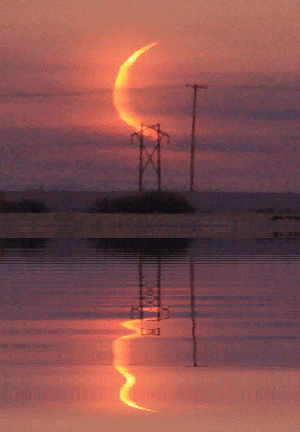
Sunday, February 22, 2009
Sunrise Images and A Total Solar Eclipse

I am so sick and tired and tired of being sick and tired of winter, it's either frigging cold or it warms up only to snow. The weather here needless to say has not been cooperating with my celestial viewing habits, missed the Lunar/Pleiades conjunction earlier this month and this morning missed the Lunar, Mercury, Jupiter, Mars conjunction due to clouds, all was not lost though, the clouds which prevented me from seeing and imaging the planets allowed me to capture a beautiful Sunrise.
Atmospheric refraction stretched out the bottom of the Sun giving the it a cool oblonged shape.
Even got a Green Flash.
As well as a Red Flash
I'm hoping the weather will work with me March 2, the next major conjunction. Look to the West the evening of March 2 for another gathering of the Moon and Pleiades, they will be close together most of the night in North America but will be their closest together as the pair sets together around 2:30 am CST.
We had a penumbral eclipse February 9, oh and by the way I missed it as well due to clouds. A Penumbral eclipse is when the Moon passes through the Earth's penumbral shadow, what you see is a slight Earth shadow on the Lunar surface making part of the Moon look darker. The Japan Aerospace Exploration Agency released what the event looked like from the Moon. Using Kaguya's, High Definition camera, the orbiter captured a beautiful image of what we know all too well , the diamond ring effect that happens during a Total Solar Eclipse here on Earth, very pretty.
Kaguya is Japan's Lunar Orbiter who's mission it is to gather data such as the Moon's mineralogy and geographic data as well as magnetic and gravity field information so as to better understand the Moon's origin and evolution. Kaguya is expected to ends it's mission with a controlled fall to the Lunar surface sometime in June. I'll leave you now with a clip of the event.
Wednesday, February 18, 2009
NASA and The ESA Are Going To Jupiter and Saturn

NASA has just released a major announcement. Two outer planet flagship missions have been given the go ahead for further studies and eventual implementation.
1. The Europa Jupiter system mission
2. The Titan Saturn system mission.
What is too cool about this announcement is that most everybody was expecting approval of one or the other, not both. NASA and the European Space Agency working closely together hope to finally answer the question, is there life elsewhere in the universe.
The Europa Jupiter mission has been given priority, launch date 2020. Two orbiters, one built by NASA one by ESA will arrive at Jupiter in 2026. The orbiters will study Jupiter, Io, Europa, Ganymede and Callisto.
I was able to reach Dr.Richard Greenberg over the phone and ask him a few questions about the Europa Jupiter mission. Dr. Greenberg is Professor of Planetary Sciences at the University of Arizona. He has written two books on Europa, "Unmasking Europa" a book for general audiences and "Europa The Ocean Moon" a more detailed book and suited for undergraduates.
Dr. Greenberg was part of a science definition team assembled by NASA to put together facts they already knew about Jupiter, Saturn and their moons and to come up with the best ideas for the two missions. When I asked Dr. Greenberg what his research group's main goal was now, he stated to continue to do research and interpret what they now know as much as possible so that when the mission is finally designed and run it will be done with as much knowledge as possible.
Dr. Greenberg who's background is in Celestial mechanics, meaning the study of the orbits and rotations of planets and their moons, first put forth the idea that the moons of Jupiter, specifically Europa might be affected by tides created by Jupiter's enormous pull on little Europa, creating what we see as crisscrossing lines or cracks on Europa's surface, that an ocean is just below a thin layer crust and that if we were able to examine the slush that comes up through the cracks created by the enormous tidal waves we could very well find some type of oceanic substances and perhaps samples of any organisms that might be present in the ocean.
I also asked him what we hope to learn from the Europa Jupiter mission that we haven't already discovered through the Galileo mission to Jupiter. He mentioned things like the orbiter being equipped with a laser altimeter which would measure the topography of the surface ice, something new. Radio tracking, allowing the gravitational field of Europa to be measured, not been done before, putting the two experiments results together will determine the amplitude of the tides, providing further confirmation of the unseen ocean.
The new NASA orbiter will be equipped with a very high resolution camera, you see the problem with the Galileo mission to Jupiter was the main antenna never opened so they had a limited amount of high resolution images sent back, not anywhere near the amount they would have liked, the new camera will produce near meter scale imaging, to see up close and personal, to image the surface perhaps at just the right time when slush is breaking through to the surface. Now, very cool, an orbiter radar, maybe able to once and for all determine the thickness of Europa's ocean covering crust, but most critical determine linkages between the ocean and the surface, the connection between the ocean and Europa's surface are what make it possible for life to flourish.
The Titan Saturn mission will consist of a NASA orbiter and an ESA lander and research balloon, the lander will actually land in one of the northern lakes of Titan and test for signs of life while the orbiter flys through the plumes of Enceladus, one of Saturn's moons again looking for any signs of life.
When all is said and done, two very exciting missions to look forward to. Looking for and finding life even microbial in our own solar system, our own backyard, increases the chances that we are not alone, that there is someone else out there, maybe even watching us right now.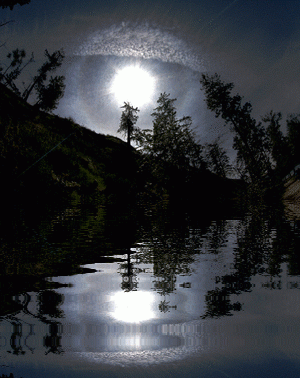
Monday, February 16, 2009
Solar Halo and Really Big Moon

People I'm so happy. While organizing my more then 23,000 images I've taken over the last 14 months I came across a folder called "Future Posts" and found some images I'd thought I had lost.
The image above is a Solar Halo I took last May on my trip to visit my daughter and boyfriend in Winfield, near Kelowna. What is remarkable about this Solar Halo is that it was taken when it was +25c, very rare. Didn't last all that long, in fact you can see the clouds roll in to dissolve it.
Now just the other day I went out to capture a daytime Moon Set. The sky was full of ice crystals usually if you can image the Moon set low on the horizon when the atmosphere is full of ice crystals it looks unusually large, didn't disappoint. the Moon looked huge, very cool, snapped an image before it ducked below the lower clouds.
This coming February 22nd, there is going to be a beautiful conjunction to look forward to. Just before Sunrise look to the East, South East around 8:00 am CST. for a super duper gathering of the slim crescent Moon, then Mercury, then Jupiter, then Mars. Will be really pretty and rare, perfect photo op. Around 7:20 am CST, you'll see the Moon rise, then below and to the left Mercury will rise, then Jupiter, finally Mars, good luck with the viewing and imaging.
Going through my images I decided to put together a compilation of some of my "thought I'd lost images" with some older favorites. Most of them taken with my Canon 40D, some with my microscope and others like some of the Moon shots taken with my camera attached to my scopes. I have all of you to thank for these images, if I wouldn't have gotten so much encouragement from you readers I probably wouldn't have taken so much in such a little time, if you would have come back in the comments and said things like " Your images suck, this blog sucks, oh and you suck", I probably wouldn't have stood out in the -40c weather to take as many as I did. The video shows as well a never before seen on this blog a cross polarized Asteroid Vesta meteorite as well as one of my favorite Lunar DAG 400 meteorites, it looks cool, gray and cratered , much like the Lunar surface itself, hope you enjoy.
Thursday, February 12, 2009
The Fastest, Smallest, Biggest and Most Explosive

National Geographic Channel comes through for us again, this time with three new premiers, count em, three, The Fastest, The Biggest and Smallest and The Most Explosive. This coming Sunday February 15 starting at 8 pm EDT. National Geographic, using Computer Generated imagery (CGI), time lapse sequences, and easy to understand demonstrations takes you on a journey through our cosmos. Starting with The Fastest.
When exploring our universe, fastest is bestest. Exploration of space depends on speed, the faster we go the more we explore, the more we learn. You'll see new and emerging technologies to get us to where we gotta go, fast. Like the new Magneto Plasma Rocket, funneling hot plasma through magnets to produce lots of thrust, thrust= speed, propelling us to hundreds of thousands of miles per hour, getting us to places like Mars in 39 days instead of the chemical rocket time of 260 days. Less time in space means less deadly cosmic radiation exposure for the Astronauts. Seriously.......being confined for 260 days with a group of people with no sex and drinking recycled urine, the whole deadly cosmic radiation thing doesn't even rate on my "things to worry about list", given the choice leastest is better. But even hundreds of thousands of miles an hour aren't fast enough to take us to the outer reaches of our galaxy, then the universe, enter worm holes and warp drive, we are only limited by our imaginations.
In the "Smallest and Biggest" you see the vastness of our universe down to the infinitesimal particles that make up everything. You'll see how nano technology is making advances in medicine with nanodiamonds delivering chemotherapy drugs to cancer cells killing them off, image above.
Now my most favorite show, "The Most Explosive", who doesn't like a good explosion? You'll see lots, volcanoes, Super Novas, Gamma Ray Bursts and the ultimate, The Big Bang. You'll also see the coolest animation of an asteroid strike.
We just had a meteoroid hit Saskatchewan skies November 20 last year, they figure it was only the size of a desk yet It was seen by thousands of people from British Columbia to Manitoba. Can you imagine seeing a 10 km size rock, the size they think caused the mass extinction of the dinosaurs enter the atmosphere, what a show it must have put on, that would be too cool to watch, a literal once in a life time thing, mostly because you be dead after. One can only imagine what the dinosaurs were thinking........"Crap, we... are... so... fracked". The Big Bang, the biggest explosion ever. In a billionth of a billionth of a billionth of a second, space time exploded into matter billions of miles across and created all the substance we know of today, all the ingredients for every explosion to follow. If you happen to miss the Sunday shows, they will be repeated Thursday February 19 starting at 7:00 pm EDT. These are American times only, Canadian times to follow once I know.
One last thing, a couple of satellites, one American and one Russian, both communication, collided 790 miles above Siberia Tuesday, what are the odds? I mean space is generally pretty big, kind of makes you feel it is getting crowded up there. No immediate risk to the International Space Station but they are monitoring the resulting 600 pieces of debris, which they feel will eventually fall to Earth and burn up in our atmosphere over the next few years. Unfortunately there are no pictures, I guess there aren't a whole lot of camera carrying tourists over in Northern Siberia.
Going through my images I've taken over the last year I came across my favorite lunar eclipse image, the blues and turquoise were cause by the sunlight passing through our ionosphere, which scatters the reds and allows the greens and blues through to the lunar surface, too cool, thought I would make an animation of it, next total lunar eclipse isn't until December 21 2010, long way to go.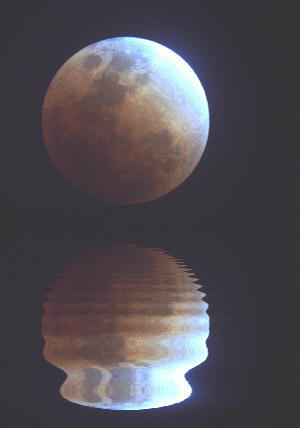
Saturday, February 7, 2009
The Angrite Meteorite
 Sahara Angrite 99555 40x Cross Polarization
Sahara Angrite 99555 40x Cross Polarization
A while back I posted about my Saskatchewan (Buzzard Coulee) meteorite. Well a reader..... we'll call him Mike...mostly because that is his name, emailed me telling me he had a Buzzard Coulee meteorite as well. So we conversed back and forth about meteorites and the like and he happened to ask me whether or not I had ever imaged my thin slices in cross polarization, I thought to myself, "who's doing what now?", and he explained. Sahara Angrite 99555 thin slice
Sahara Angrite 99555 thin slice
I had seen images of colorful meteorite thin slices before, but never knew how they got the pretty colors to show, some are just to die for. Long story short Mike sent me a couple of films to do some imaging with, for free, very cool. Microscope and alien
Microscope and alien
You sandwich your meteorite thin slice in between the polarization films, which does it's magic and allows Meteoriticists (meteor scientists) to determine the mineral and chemical composition of the meteorite therefore giving them a better idea how the meteorite formed in the first place. I like taking the images because I am creating art, they kind of remind me of abstract art or stained glass windows. Sahara Angrite 99555 40x Cross Polarization
Sahara Angrite 99555 40x Cross Polarization
Angrites are the rarest, most sought after, most mysterious and studied meteorite in the world, to date only around 50 pounds worldwide have been collected. The only thing they know for sure is that they came from a large body near the Sun. Some Meteoriticists believe they originated from Mercury, no conclusive proof either way but we should know a little more when Messenger reaches orbit around Mercury in March 2011 and does some surface composition analysis, giving the Meteoriticists another piece to the Angrite puzzle, compare the known samples of Angrites with the Messenger data to see if there are any similarities.
Okay, I'm going to do something a little bit different, going to step out of my comfort zone, instead of posting a reflective water animation I'm going to do a rotating square collage, I know, I know, call me crazy and wild, but I thought I would switch it up a bit.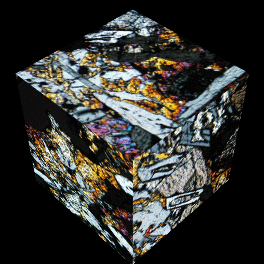
Wednesday, February 4, 2009
Rare Lunar Red Flash, Moon Pleiades Conjunction and Obama's Inauguration

Totally missed the Moon and Pleiades Conjunction due to clouds but both Roger and Genie were fortunate to view and image the gathering, images below. I did however catch a couple days ago an extremely rare lunar red flash, very rare and even more rare when the Moon is in it's crescent phase. The Red flash is caused by atmospheric refraction, bending and distorting the bottom of the Moon and scattering the blues of the moonlight and allowing the reds through to be seen by the viewer.Roger's Moon/Pleiades Conjunction image, February 3 2009
 Genie's Moon/Pleiades Conjunction image, February 3 2009
Genie's Moon/Pleiades Conjunction image, February 3 2009
Way to go Roger and Genie, and a heads up, this coming March 2 another Moon/Pleiades conjunction will be taking place, take advantage of them, the Moon is in the right position for them to occur till 2010, after that it will be slim pickins till 2022.
Congratulations go out to Genie as well, she got her images on CNN's iReport, very cool!! Using Mars Rover imaging technology, David Bergman put together a 1,474 megapixel image of the Barack Obama inauguration. NASA developed what they call Pancam, a camera able to tilt 180 degrees, rotate 360 degrees and take high resolution images. Software stitches 1 megapixel images together and smooths out anomalies, result, a stunning high resolution image. This software helps scientists study the Martian surface through the rover's cameras like they are actually there. You can view the more then 1,400 images taken from the main 1,474 image here.
Using Mars Rover imaging technology, David Bergman put together a 1,474 megapixel image of the Barack Obama inauguration. NASA developed what they call Pancam, a camera able to tilt 180 degrees, rotate 360 degrees and take high resolution images. Software stitches 1 megapixel images together and smooths out anomalies, result, a stunning high resolution image. This software helps scientists study the Martian surface through the rover's cameras like they are actually there. You can view the more then 1,400 images taken from the main 1,474 image here.
Even though I am not into politics or celebrity it is kind of addicting to go through some of these images and pick out people like Beyonce and Jessica Alba.
I'll leave you now with an animation of a Sunset I took the other day.